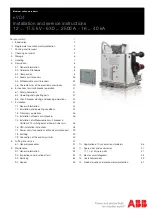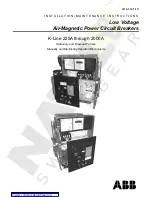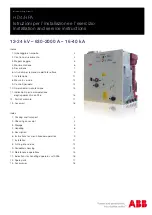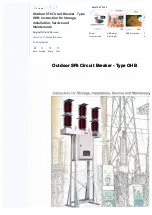
GENER
AL
PR
ODUCT
OPER
A
TION
SCREEN MODE
...
CURVES
INST
ALL
A
TION
C
ONNECTION
LOCKS
BREAKER ME10
INTRO
BREAKER
ACCESSORIES
TESTS
APPENDIX
TRIP UNIT
O
THER
2-16
2.2.3.5 Protezione istantanea ridotta (RELT)
II Relè di protezione tipo GT-N e GT-H sono dotati
di una protezione istantanea ridotta (RELT).
L'INPUT 1 è assegnato a questo dispositivo, che
può essere attivato con un segnale a 24 VDC o
AC.
La funzione RELT offre una funzione di intervento
istantaneo più veloce, che può essere utilizzata
nei casi in cui sia temporaneamente richiesta
una protezione più rapida e più sensibile dai
cortocircuiti.
Il dispositivo è impostato separatamente ed ha
una soglia di intervento che può essere
impostata a incrementi di 0,5 x il valore di
corrente impostato dall'utente Ie, su un
intervallo da 1,5 x Ie a 15 x Ie (limitato a un
massimo di 13 x Ie sul modello a 6400A).
Per consentire l'utilizzo della funzione RELT,
assicurarsi che sia impostata su ON nel menù di
configurazione. A questo dispositivo viene
automaticamente assegnata l'uscita relè 1,
consentendo l'indicazione dello stato in REMOTO.
2.2.3.6 Protezione da guasto a terra (GF)
Tutti i Relè di Protezione di tipo GT-E, S, N e H
possono essere opzionalmente dotati di un
dispositivo di protezione di guasto a terra
residuale. I Relè di Protezione tipo GT-H possono
opzionalmente essere dotati di un set di due
protezioni di guasto a terra come indicato di
seguito:
--
GFsum:
che opera in base al principio della
corrente differenziale.
--
GFct:
che opera in base al principio di ritorno
a terra.
Protezione di guasto a terra GFsum
Il dispositivo utilizza i sensori Rogowski interni
dell'interruttore per misurare e sommare le
intensità di fasi e neutro. Quando in un
interruttore a 3 poli viene scelta l'opzione di
guasto a terra, nella maggior parte delle
applicazioni (4 fili) è necessario un quarto
sensore esterno. La distanza tra l'interruttore e il
sensore esterno deve essere limitata a 10 metri.
Quando il dispositivo rileva una corrente, il Relè
di protezione ME10 fa intervenire l'interruttore
scollegando quindi il circuito o, opzionalmente,
producendo un segnale di allarme.
La banda di tolleranza della protezione GF è il
15% della corrente impostata (Ig). Le soglie di
intervento di guasto a terra sono impostate
come multipli di x CT (CT = In dell'interruttore) a
passi di 0,01 x CT.
Senza un'alimentazione ausiliaria, il campo di
regolazione è limitato da 0,2 a 1 xCT. Quando è
collegata un'alimentazione di controllo a +24
VDC, il campo di regolazione aumenta da 0,1 a 1
x Ict. (= In dell'interruttore ME10)
Protezione da guasto a terra GFct
Questo dispositivo prevede uno schema di
protezione di guasto a terra alternativo (detto
anche “Source Ground return") in cui la corrente
del neutro è misurata da un quarto sensore (di
neutro) posizionato nel punto di messa a terra
dell'impianto.
Questa opzione richiede l'uso di una tensione
ausiliaria di 24 VDC, mentre il Relè i Protezione
elettronica deve avere l'opzione di ingresso CT
'attiva'.
Un TA di collegamento a terra deve essere
posizionato nelle immediate vicinanze
dell'interruttore mentre un TA di isolamento deve
2.2.3.5 Reduced Energy Let-Through
Instantaneous Protection (RELT)
The trip unit types GT-N and GT-H are provided
with a Reduced Let Through Instantaneous
function (RELT) . INPUT 1 is assigned to this
device that can be activated with a 24V DC or AC
signal.
The RELT function provides a faster
instantaneous trip function that may be used in
cases where a faster and more sensitive
protection against short circuits is required
temporarily.
The device is set separately and has a pickup
value that can be set in steps of 0.5 x the set
user current value Ie with a range of 1,5 xIe to
15 xIe. (limited to a maximum 13 x Ie on the
6400A type).
To allow the use of the RELT function please
assure that it is set to ON in the set up menu.
Relay output one is automatically assigned to
this device allowing a REMOTE status indication
of the device (ON or OFF).
2.2.3.6 Ground Fault Protection (GF)
All GT-E, S, N and H type trip units can be
optionally equipped with a Residual Ground
Fault Protection device . The GT-H trip unit types
can optionally be equipped with a set of two
ground fault devices as follows:
--
GFsum
:That operates on the Residual Current
device principle.
--
GFct
:That operates on the Source Ground
Return principle.
The GFsum Ground Fault Protection
The device utilizes the internal Rogowski sensors
in the circuit breaker to measure and to
residually sum all phase and neutral currents.
When the groundfault option is chosen on a 3
pole breaker an additional 4th external sensor is
required for most applications (4 wire). The
distance between the circuit breaker and the
external sensor is limited to 10 metres. (33 f)
When the device detects a fault current the
ME10 trip unit trips the associated Circuit
breaker thus disconnecting the circuit or ,
optionally, produces an alarm signal.
The GF pickup value tolerance band is 15% of
the set current (Ig). The ground fault pickup
settings are set as multiples of x CT (CT=In of the
circuit breaker) in steps of 0.01 x CT.
Without an auxiliary supply the setting range is
limited to 0.2 to 1 xCT. When a +24V DC control
voltage supply is connected the setting range is
increased to 0.1 to 1 x Ict. (=
In
of the ME10
Breaker)
GFct Ground Fault Protection
This device is an alternative earth fault
protection scheme in which the Neutral Current
is measured by a 4th, or neutral sensor placed
at the earthing point of the system.
This option requires the use of an auxiliary
supply of 24VDC and the Electronic Trip Unit
must have the option CT input 'active'.
An Earth leg CT needs to be placed in the near
vicinity of the breaker and an interposing CT
needs to be mounted in the breaker. When the
2.2.3.5 RELT-Schutz
(reduzierter Schnellschutz)
Die ME10 Auslöseeinheit Typ GT-N und GT-H
bieten eine 'Reduced Energy Let-Through
Instantaneous Protection' RELT-Funktion.
Eingang 1 ist dieser Funktion zugeordnet und
wird über ein 24 VDC oder AC Signal aktiviert.
Die RELT-Funktion bietet eine schnellere
Schnellauslösungsfunktion, die verwendet
werden kann, wenn ein schnellerer und
empfindlicherer Schutz gegen Kurzschlüsse
vorübergehend erforderlich ist.
Das Gerät ist getrennt einstellbar und hat einen
Einstellwert, der in Schritten von 0,5 x auf den
gesetzten Nutzerstromwert Ie mit einer
Bandbreite von 1,5 xIe bis 15 xIe gestellt werden
kann.
(beschränkt auf max. 13 xIe für den 6400A
Typ).
Um die Verwendung der RELT-Funktion zu
nutzen, muss sie im SETUP-Menü auf EIN gestellt
werden. Relaisausgang 1 wird automatisch zur
Fernstatus-Anzeige der RELT-Funktion (AUS oder
EIN) auf diesen Schutz gesetzt.
2.2.3.6 Erdschlussschutz (GF)
Alle GT-E, -S, -N und -H-Auslöseeinheiten können
optional mit Erdschlussschutz ausgerüstet
werden. Der GT-H Typ kann optional mit zwei
Erdschlussschutz-Prinzipien ausgerüstet werden:
--
GFsum:
Funktioniert nach dem Fehlerstrom-
Prinzip.
--
GFct:
Funktioniert nach dem Source Ground
Return Prinzip.
Das Fehlerstrom-Prinzip (GFsum)
Der Schutz nutzt die internen Rogowski-
Wandler im Schalter zum Messen und zum
Summieren aller übrigbleibenden Phasen- und
Neutralströme. Wenn die Erdschluss-Option mit
einem 3-poligen Leistungsschalter gewählt wird,
ist ein zusätzlicher 4ter externen Wandler für die
meisten Anwendungen (4-Draht) erforderlich.
Der Abstand zwischen dem Leistungsschalter
und dem externen Wandler ist auf 10 Meter
begrenzt.
Wenn das Gerät einen Fehlerstrom erkennt, löst
die ME10 Auslöseeinheit den entsprechenden
Leistungsschalter zur Schaltkreistrennung oder
optional zur Signalerzeugung aus.
Der GF Einstellwert-Toleranzbereich ist 15% des
eingestellten Stroms (Ig). Die Erdschluss-
Einstellwerte sind als Vielfaches von xCT (CT = In
des Leistungsschalters) in Schritten von 0,01 xCT
einstellbar.
Ohne Hilfsspannung ist der Einstellbereich auf
0,2 bis 1 xCT begrenzt. Wenn eine +24VDC-
Spannungsversorgung angeschlossen ist,
erhöht sich der Einstellbereich auf 0,1 bis 1 x Ict.
(=
In
des ME10 Leistungsschalters)
GFct Erdschlussschutz
Dieser Schutz ist ein alternatives
Erdschlussschutzschema, in dem der
Neutralleiterstrom in einem Vierten oder
Neutralwandler, am Systemerdungspunkt,
gemessen wird.
Diese Option erfordert die Verwendung einer
Hilfsspannung von 24VDC und die Elektronik-
Auslöseeinheit die Einstellung: Wandler (CT)-
Eingang 'aktiv'. Ein Erdschlussstromwandler
muss in der Nähe des Schalters und ein
Zwischenstromwandler im Leistungsschalter
















































